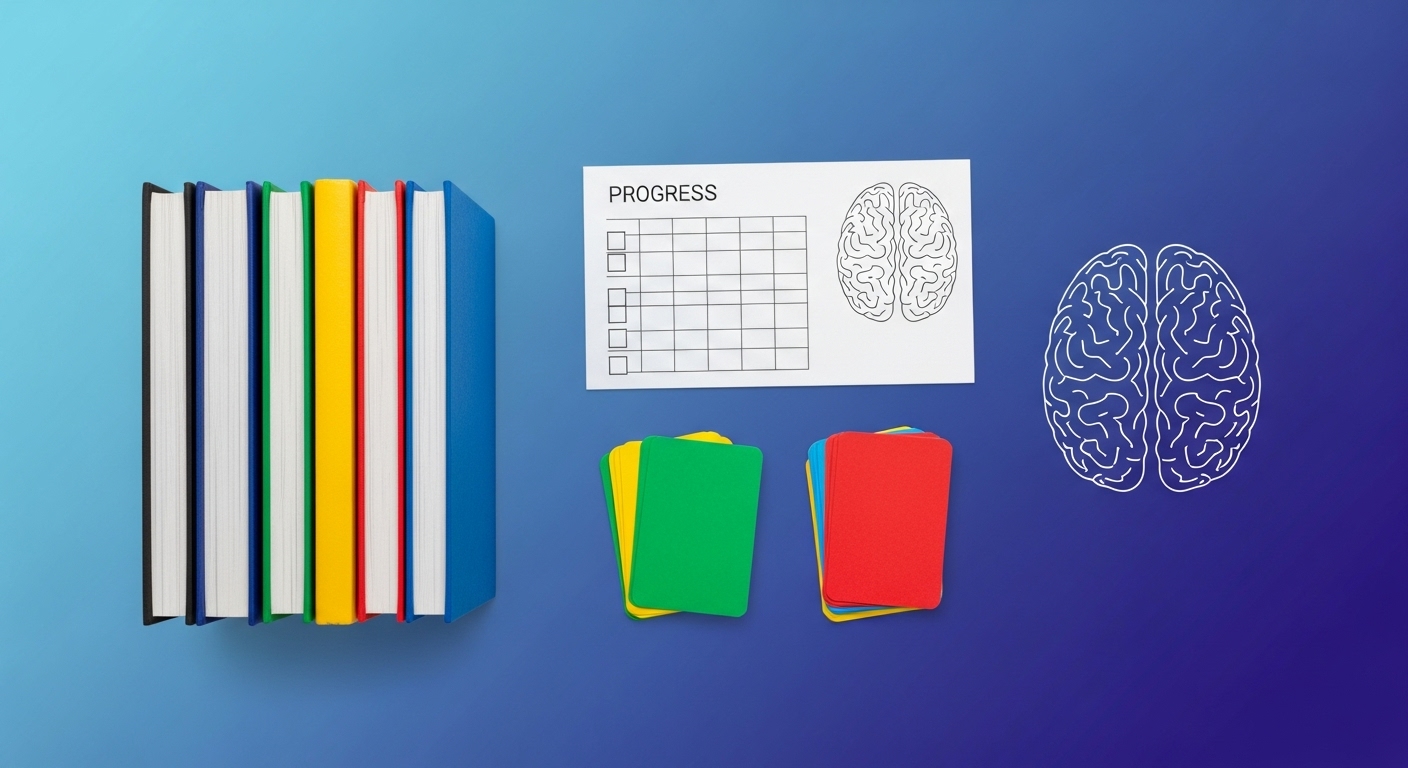
5 Proven Language Learning Strategies That Actually Work
A practical, science-aware guide to building real language momentum: spaced repetition, input balance, immersion pockets, communication focus, and smart tech—without overwhelm.
TL;DR
A practical, science-aware guide to building real language momentum: spaced repetition, input balance, immersion pockets, communication focus, and smart tech—without overwhelm.
Table of Contents
Need help turning messy notes into clean flashcards?
MemoForge pulls highlights, structures prompts, and exports straight to Anki so your study time stays focused on recall.
5 Proven Language Learning Strategies That Actually Work
Language learning: creating an effective study environment and mindset
Feeling stuck between grammar drills, vocab lists, and that podcast everyone swears by? You're not alone. Most learners know a dozen methods—what's missing is a simple system that compounds. Below are five pillars used by successful polyglots, test‑takers, and casual learners who actually stick with it past month three. Plus a bonus tech layer (used wisely, not obsessively).
<!-- Simplified overview (removed large mermaid diagram) -->At a glance: Spaced repetition · High quality input first · Micro immersion pockets · Communication focus over perfection · Light, purposeful tech.
1. Spaced Repetition: Tiny Reviews, Big Retention

Yes, you've heard it. But are you really using it consistently? Spaced repetition schedules reviews right before forgetting peaks. That little friction spike—recalling a word just as it's fading—cements it.
Simple Interval Pattern (Slim Version)
New → 1d → 3d → 7d → 14d → 30d → 60+ d
Miss a recall? Drop that card back 1–2 steps instead of restarting entirely.
Make It Work For You
- Keep daily new cards modest (15–30) rather than a binge
- Add example sentences (context multiplies retention)
- Tag by theme (travel, health, verbs, exam-section) for targeted bursts
- Delete junky or duplicate cards fast—clutter kills motivation
Quick win: Generate a first-pass set automatically (e.g., MemoForge), then trim and tighten wording before exporting to Anki.
2. Input Before (Serious) Output—But Not Forever
Early output obsession leads to fossilized errors and discouragement. Treat the first phase like “soaking your brain” in accessible content.
Input Balance Guideline (Replaces journey diagram)
| Stage | Input % | Output % | Focus Highlights |
|---|---|---|---|
| Beginner | ~80 | ~20 | Listening, graded reading, mimic short chunks |
| Lower‑Intermediate | ~60 | ~40 | Controlled chats, short answers |
| Upper‑Intermediate+ | ~50 | ~50 | Narration, opinions, debate |
Quality Input Sources
- Graded readers or bilingual readers
- Podcasts + transcripts (read once, then listen blind)
- YouTube channels teaching topics you like, not just grammar
- Subtitled shows (target language subs → later none)
If you understand ~75–85% without constant lookup, you’re in the sweet spot—challenged but not drowning.
3. Comprehensible + Compelling Beats Random Exposure
Not all exposure counts. Scrolling social media in your target language doesn’t guarantee acquisition if it’s fragmented slang you can’t parse.
Effective input is:
- Comprehensible: Majority recognizable, minority stretching
- Compelling: You’d consume it even if not studying
- Pattern-Rich: Repeated structures (past tense forms, honorifics, case endings)
Rough Material Ladder
| Level | Reading | Listening |
|---|---|---|
| A1–A2 | Graded tales, simple news digests | Slow learners' podcasts, children’s shows |
| B1 | YA fiction, interest blogs | Standard TV, interviews |
| B2 | Long-form articles, light nonfiction | Faster talk shows, documentaries |
| C1+ | Literature, academic / domain texts | Debates, lectures, unscripted panels |
If a source feels like static—dial it down. Strain ≠ progress.
4. Build “Language Islands” (Micro Immersion on Demand)
You might not move countries tomorrow. Fine. You can still carve out pockets where your brain expects the target language.
Island Ideas
- Morning mirror talk: narrate getting ready
- Commute: swap playlists for a serialized audio series
- Cooking: follow recipe in target language—out loud
- Work break: 10‑minute silent reading sprint
- Fitness: count reps + short self‑pep talks
Implementation Mini-Plan
- Choose two daily slots (e.g., breakfast + commute)
- Preload content—reduce friction to zero
- No translation safety net during those windows
- Expand islands gradually (not all-day heroics)
Consistency grows automatic recall—and reduces the mental “gear change” when speaking.
5. Communication Over Perfection (Perfection Comes Through Use)
You will misgender nouns. You will botch verb aspect. The learners who progress refuse to stall on micro-corrections mid-conversation.
Practical Mindset Shifts
- Mistakes = data, not failure
- Frequency first: high-value verbs, connectors, pattern chunks
- Approximate if needed: “thing for cutting bread” beats silence while searching “serrated knife”
- Ask: “How would a native say that?” (gold feedback prompt)
High-Utility Communication Tactics
- Circumlocution: Describe the function (“the tool that…”)
- Anchoring gestures: Reinforce meaning non‑verbally
- Chunk memorization: Learn phrases (“as far as I know”, “on the other hand”) as single units
- Self-recording: 2-minute daily monologue → review → tweak
Bonus: Use Technology—But Don’t Worship It
Tech accelerates workflow, not discipline. Choose a minimal stack you’ll actually maintain.
Smart AI Uses
- Generate draft vocab + concept cards from a textbook chapter
- Turn messy notes into structured Q/A format
- Produce bilingual cards with examples and part-of-speech tags
- Convert transcripts into cloze deletions
Still Valuable Old-School Tools
- Handwritten jotting for forms you keep forgetting
- Shadowing audio (pause, mimic rhythm, continue)
- Live exchange partners (humans force adaptive retrieval)
If an app feels like busywork, eject it. Tool switching burns time you could spend acquiring language.
Putting the Pieces Together (A Sustainable Loop)
Input feeds comprehension → comprehension feeds meaningful output → spaced repetition stabilizes form → islands reduce activation cost → communication practice accelerates automaticity. That reinforcing loop is the game.
A 30-Day Starter Blueprint
Week 1–2 (Foundation)
- 30 min listening (graded or transcripted)
- 15 min reading
- Generate + prune 60 AI draft cards (keep best 40)
- Daily SRS review (under 12 min)
Week 3–4 (Activation)
- Keep input routine
- 10 min speaking aloud / recording
- 2 language islands daily (10–15 min each)
- Add 5 application cards (use cases, scenarios)
- One weekly exchange or AI chat simulation
After Day 30
- Gradually raise challenge (harder input, more spontaneous speech)
- Retire overly easy cards
- Add focused “problem sets” (e.g., past tense exceptions)
Momentum matters more than raw hours.
Quick FAQs (Straight Answers)
How many cards per day? Enough to stay consistent—often 15–25 new; review load under 120.
Should I translate everything? No. Use quick recognition early, then push monolingual definitions.
When start speaking? Light mimicry early, heavier output once comprehension feels stable.
Do I need grammar drills? Target trouble spots surgically—don’t live in exercise books.
How do I stop forgetting old words? Tag leeches (habitually failed cards) and rewrite them clearer.
Why Use MemoForge in This Stack?
Because the card creation bottleneck kills momentum for most learners. MemoForge:
- Parses PDFs, notes, chapters quickly
- Accepts scanned textbook content once you export a clean, OCR (searchable) PDF—so the text can be segmented properly
- Suggests varied card types (definition, contrast, scenario, cloze)
- Lets you regenerate a single weak card instead of redoing a whole batch
- Exports directly to Anki (APKG), CSV, TSV
- Keeps decks lean—so you actually finish reviews
Faster generation → better refinement → cleaner spaced repetition sessions.
Your First Micro-Win (Do It Today)
- Pick one short article or lesson (not a giant textbook—yet)
- Upload + generate draft deck
- Delete fluff, tighten 10 weakest answers
- Export + study 20 new
- Show up tomorrow. Repeat.
That loop—small, repeatable—beats any grand plan you abandon.
Ready to try it? Create a free MemoForge account, upload a single clean text or PDF, and produce a deck before your coffee cools. Turn passive exposure into structured recall—start now.
Related Articles

Anki Backlog Rescue: Settings, Habits, and Filters to Clear Reviews Fast
Pause new cards, set time-based review caps, use parent deck limits, and build rescue filtered decks to eliminate your Anki backlog without burnout.

10 Ways AI Can Boost Your Study Productivity (Without Making You Dependent)
Practical, grounded ways students can use AI—planning, flashcards, memory cues, spaced review, synthesis—while keeping agency and critical thinking intact.

How to Use Anki: Step-by-Step Beginner Guide (2025)
Install Anki, build your first deck, choose the right settings, and set a daily review routine with AI tips to stay consistent.